
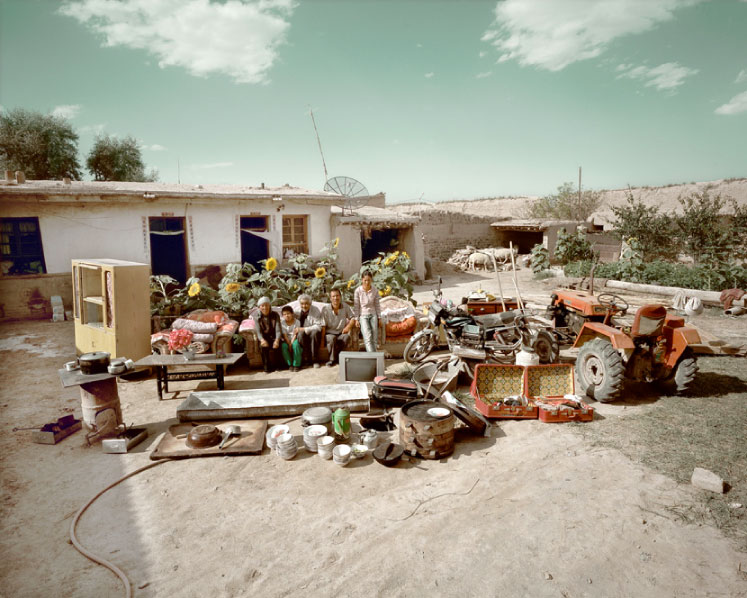
All photography by Huang Quingjun and Ma Hongjie (Click images to enlarge)
 Family Stuff
Family Stuff, a photojournalism project by Beijing-based photographers
Huang Quingjun and
Ma Hongjie, has been circulating among blogs for a couple of years now. We came across it recently and wanted to share the work. Huang and Ma juxtapose the results of China’s economic progress with its enduring poverty – often in the same household – by documenting families and their belongings arranged outside of their homes.
The photographers capture Chinese families from various regions and ethnicities. Ma in particular focuses on the country’s rural majority, rather than the urban population more frequently displayed by the media. While to first-world eyes the number of possessions appears scant, their owners are obviously proud of what they’ve gained in recent times. Occasionally, too, other faces are more troubled, as seen in the expressions of a family in the resettlement program in Beijing, waiting to move to a new home so their old residence can be demolished.
Huang and Ma work completely independently of one another: Huang covers the Northern half of China while Ma documents the South. The shoots can take months to finish. Although families are compensated for their trouble, the task of explaining the project and convincing families to so nakedly display themselves and their possession often proves difficult. Six years in the making, this epic project will result next year in fifty photos and a book.
(more…)


Beverly Ridge All artwork courtesy of Cheryl Molnar. (Click Images to Enlarge)

 Cheryl Molnar
Cheryl Molnar has lived in New York for most of her life. Born and bred on Long Island, the young collage artist currently lives and works in Greenpoint, Brooklyn. Fascinated by the shifts and alterations constantly happening to the urban locales in which she lives, Molnar creates intricate, powerful collages that capture tenuous moments of architectural change. We interviewed Molnar via e-mail about gentrification, her unique choice of artistic medium, and an intriguing future project on the rapidly-changing Williamsburg/Greenpoint waterfront.
You grew up on Long Island and currently live in Brooklyn. How have the places you’ve lived influenced your work, and what draws you to depict them?
I have always been sensitive to my surroundings. Growing up in a working-class neighborhood on Long Island, I spent time in a place that was engineered to provide young families with the “American Dream” — new (at the time) ranch houses, “modern” appliances, a small patch of green space and a driveway. But the structures and goods, manufactured to supply this dream, were generally poorly constructed, impersonal and generic. This “assembly line” production not only prevented neighborhoods from developing any lasting character but did not integrate itself into the natural surroundings. This disregard for nature deeply affected me and is one of the central themes in my work.
(more…)
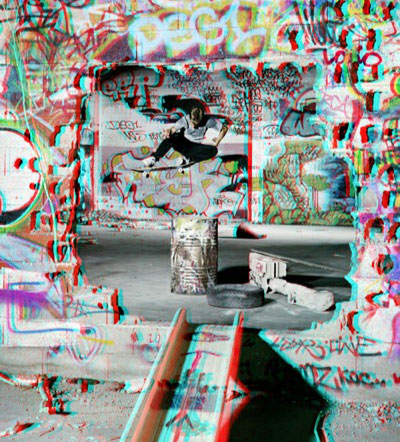
SCENE 3, Gabriel Engelke (Switch Ollie) © Sebastian Denz

Spend a few hours at a local skate park, and it becomes clear that the dynamism of the halfpipe’s gravity-defying techniques often gets lost in translation from reality to a two-dimensional photograph. Long confined to the realm of motion picture spectacles, German photographer Sebastian Denz uses 3-D imagery to capture “a hybrid space that is in between virtual and real,” one kickflip at a time. Armed with a custom built apparatus assembled by camera specialist Dr. Kurt Gilde, Denz has been on the road with streetwear brand Carhartt’s European skateboard team for the past three years, capturing the athletes in “hyper-reality.” Unlike the comfort of a dark theater, however, these spatial photographs are not about audience passivity, but rather “creating [one's] own construction of reality within these spaces” – a far cry from, say, the lush escapism of Pandora in IMAX.
Carhartt Presents Skateboarding.3D is on display at the Carhartt store in Rome from May 7 through May 26.
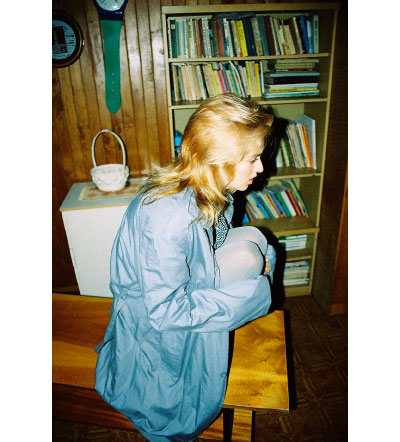
Photography by Lukasz Wierzbowski (Click Images to enlarge)

The photography of Lukasz Wierzbowski — a photographer and social psychology student currently living in Wroclaw, Poland — unsettles. His pictures feature gorgeous young women in the woods or at home or on the street; wherever they are, their figures alone occupy the frame. Draping themselves across tree branches, grassy lawns, or unkempt bedspreads, these women seem bored and frustrated with the viewer’s gaze — in almost every image, the face of the model is turned away, obscured, or simply facing the camera with eyes staunchly shut. There is something uncanny about these pictures; looking at them, the viewer feels implicated as voyeur into someone else’s private world.
Despite the fact that his work appears rich with implied meaning, Wierzbowski explains that he doesn’t have any kind of artist statement: “The only thing I can say [about my work] is that I feel strongly attached to this certain mood, feeling of in-between where not everything is the way it seems.” Indeed, Wierzbowski’s images bring to mind that old joke: “I woke up this morning and discovered that someone had stolen all my stuff and replaced it with exact replicas.” While the world in these pictures looks just as we expect it to, something in the atmosphere just doesn’t feel right.
(more…)
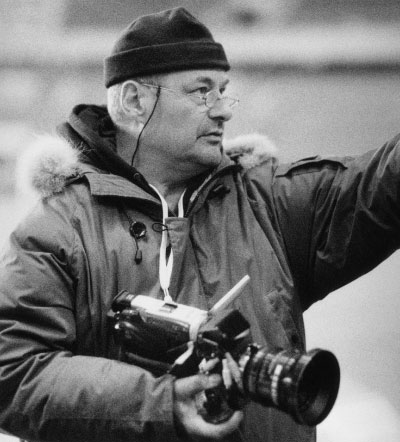
 Jean-Pierre Jeunet, the French director best known for his film Amelie is many things: the pride of the French cinema, the darling of film connoisseurs, a man with a clear and unique creative vision. What he is not, contrary to what many film buffs may think, is a highfalutin artist that lives in a parallel universe where low-grade pop-culture is not allowed to enter.
Jean-Pierre Jeunet, the French director best known for his film Amelie is many things: the pride of the French cinema, the darling of film connoisseurs, a man with a clear and unique creative vision. What he is not, contrary to what many film buffs may think, is a highfalutin artist that lives in a parallel universe where low-grade pop-culture is not allowed to enter.
At 56 Jeunet has enjoyed both artistic and popular success. His first two features, Delicatessen (1991) and The City of Lost Children (1995), produced with his collaborator, Marc Caro, were well-received by film critics and went on to become cult hits. The eccentricity of both pictures, the off-kilter characters, the unique cinematographic style, and incredible attention to detail quickly became Jeunet’s signature.
On a recent afternoon in New York I sat down with Jeunet to talk about his career, his most recent film, Micmacs, and Rambo. The Tribeca Film Festival, where Micmacs premiered, just ended and Jeunet looked a bit tired, but his inquisitive blue eyes were sharp and alert. Naturally, our conversation turned to his unique aesthetic vision. The hallmark of Jeunet’s talent is his ability to create a world that is distinctly his own. In this world, the strange freely interacts with the familiar, turning the viewer into an Alice tumbling down a rabbit-hole.
(more…)
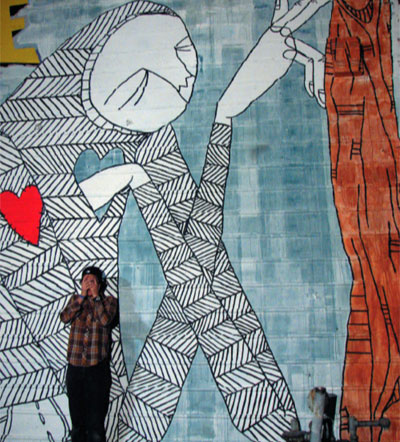
Know Hope in front of his mural A Technicality on the façade of Anno Domini Gallery. San Jose, California, 2008. All Images courtesy of Gestalten Books.

Seems you can’t move an inch anymore without running smack dab into the words ‘street art’. Increasing media exposure and growing acceptance of the method as a legitimate art form has generated an onslaught of new discussion about the crossover medium. As more art and design schools, magazines, and distinguished institutions like the Tate Modern jump onboard, the need for real information increases.
Beyond the Street is Gestalten’s comprehensive response to supply this new demand.
More of a manual than a coffee table book, the behemoth is comprised of 400 pages of in-depth interviews and full-color photographs. The book is smart, slick, and poses the long overdue questions burning in everyone’s mind. What makes street artists tick? What kind of implications does their work have on the urban landscape? Will the genre’s freedom ultimately trump the commercial art world? One hundred global power players in street and urban art are highlighted here including Wooster Collective, Shepard Fairey, Jonathan LeVine Gallery, Agnes B, and Juxtapoz Magazine.
(more…)
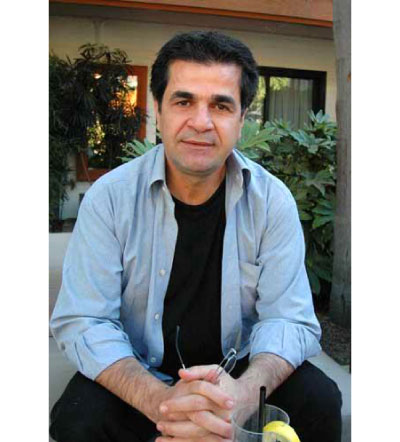
 For anyone not living there, it’s hard to know what on earth goes on inside Iran. For some, it’s a cradle of culture; for others, a breeding-ground for extremists. What is certain, however, is that the current Islamic regime doesn’t tolerate dissent, shuttling any and all opposition voices off to jail at will. Now, they have a high-profile convict to deal with: award-winning filmmaker Jafar Panahi. Many of Panahi’s films have been explicitly critical of the Iranian government, like his masterpiece Dayereh (The Circle) from 2000 — winner of the Golden Lion at Venice — which addresses the treatment of women under the Islamist regime. The story is about different women outcast from their families and on the run on the streets of Tehran — not exactly the image that Iran’s highly sensitive leaders want to project of their country. Before his arrest, they had even banned Panahi from travelling abroad, apparently for having worn an item of green clothing — the color of Iran’s opposition, favored by Iranians in exile — at the Montreal Film Festival. Now, an international movement demanding his release is gathering momentum. Dozens of high-profile cineastes like Spielberg, Redford, De Niro, Loach, and Kiarostami (who Panahi used to assist), as well as countless film entities and culture ministers around the world have signed a petition, bringing further international scrutiny to the regime. Panahi may not have intended it this way, but being cast as the martyr has brought massive media attention to the Iran he so desperately wants to change.
For anyone not living there, it’s hard to know what on earth goes on inside Iran. For some, it’s a cradle of culture; for others, a breeding-ground for extremists. What is certain, however, is that the current Islamic regime doesn’t tolerate dissent, shuttling any and all opposition voices off to jail at will. Now, they have a high-profile convict to deal with: award-winning filmmaker Jafar Panahi. Many of Panahi’s films have been explicitly critical of the Iranian government, like his masterpiece Dayereh (The Circle) from 2000 — winner of the Golden Lion at Venice — which addresses the treatment of women under the Islamist regime. The story is about different women outcast from their families and on the run on the streets of Tehran — not exactly the image that Iran’s highly sensitive leaders want to project of their country. Before his arrest, they had even banned Panahi from travelling abroad, apparently for having worn an item of green clothing — the color of Iran’s opposition, favored by Iranians in exile — at the Montreal Film Festival. Now, an international movement demanding his release is gathering momentum. Dozens of high-profile cineastes like Spielberg, Redford, De Niro, Loach, and Kiarostami (who Panahi used to assist), as well as countless film entities and culture ministers around the world have signed a petition, bringing further international scrutiny to the regime. Panahi may not have intended it this way, but being cast as the martyr has brought massive media attention to the Iran he so desperately wants to change.
For more information and ways to help, go to the Free Jafar Pahani facebook page.
(more…)



 Floria Sigismondi is the real deal. Born in Italy and raised in Ontario, Canada, Sigismondi is a 21st century Renaissance woman who has spent her career bridging the gap between film, videos, music, and photography. Her new film, The Runaways, premiered in January at the Sundance Film Festival, garnering immediate buzz and critical accolades from around the globe. Although the multi-disciplinary artist counts music videos for The Dead Weather, David Bowie, Interpol, and Björk as past projects, The Runaways is her first feature film. Deviating from the stark, surrealist dreamscapes she’s known for, Sigismondi captures the feverish rise and descent of the 1970s all-girl teenage rock group (which featured Joan Jett) with style, awe, and sensitivity. Here’s an exclusive peek with the rising director.
Floria Sigismondi is the real deal. Born in Italy and raised in Ontario, Canada, Sigismondi is a 21st century Renaissance woman who has spent her career bridging the gap between film, videos, music, and photography. Her new film, The Runaways, premiered in January at the Sundance Film Festival, garnering immediate buzz and critical accolades from around the globe. Although the multi-disciplinary artist counts music videos for The Dead Weather, David Bowie, Interpol, and Björk as past projects, The Runaways is her first feature film. Deviating from the stark, surrealist dreamscapes she’s known for, Sigismondi captures the feverish rise and descent of the 1970s all-girl teenage rock group (which featured Joan Jett) with style, awe, and sensitivity. Here’s an exclusive peek with the rising director.
What initially drew you to The Runaways and made you want to tell their story through the language of film?
I was intrigued by their age and how young they were in the world of rock and roll, touring with virtually no parental guidance. I focused the story on Joan Jett and Cherie Currie, because they were completely different people coming together for the same goal. They were breaking new ground.
(more…)

courtesy of Rizzoli Books USA

Shirin Neshat, the Iranian-American visual artist, has had an exiguous but rewarding career. Her body of work, mostly engaging the position of women vis-à-vis Islam, is scant but forceful. The new book, Shirin Neshat (Rizzoli, $75), is an ambitious effort to gather her art under one roof. The 272-page volume documents all of Neshat’s projects with photographs and stills from her videos and her first feature film, Women Without Men.
Neshat’s first undertaking, a series of photograph’s called The Women of Allah, remains her most poignant work. The photos depict Iranian women shrouded in veils and holding guns. Farsi poetry, including songs about martyrdom and sexual longing, is inscribed on their faces, hands, and feet. From Neshat, whose work is banned in Iran, one would expect a pointed critique of Islamist extremism, but the viewer doesn’t quite get that. The women don’t look like victims.
The rest of Neshat’s work is less ambivalent. The book is full of stills from her videos depicting separation of sexes and limitations of women’s personal freedom. The book culminates with stills from Women Without Men. The film deals with oppression of women in Iran. It is based on the eponymous novel by Shahrnush Parsipur, about four women who are betrayed by the society in which they live. The photos in the book succeed in freezing the characters’ complex emotions and revealing their suffering. These silent and abandoned women surely find a sympathetic voice in Neshat, whose work remains urgent and charged.
(more…)
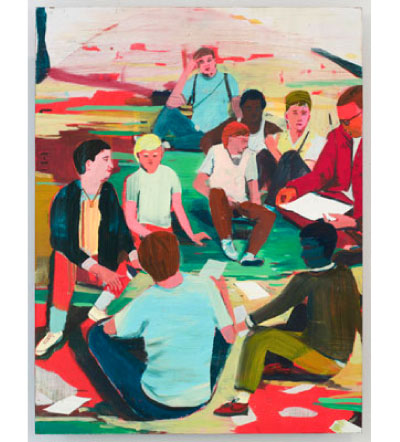
Jules de Balincourt, A Few Good Men, 2010. All images courtesy of Jules de Balincourt, A Few Good Men, 2010

If you’re searching for metaphysical rejuvenation, Jules de Balincourt mixes a potent visual tonic of apocalyptic sunbursts and fractured fortunetellers. Continuing his international successes in Paris, London, and Tokyo, the lithe 37-year-old graced Deitch’s cool gallery interiors last month with sixteen figurative and abstract paintings, marking his most extensive exhibition to date. Despite de Balincourt’s politically tinged oeuvre, his recent works have been decidedly more meditative, measuring the imprint of technology in a process of thoughtful internalization. Dense iterations of life, chaos, and computers, de Balincourt’s art presents content and form in a deliberate DIY, faux-naïf aesthetic. Oil and acrylic media, stencils, tape, knives, and spray paint are employed in equal measure.
Besides a penchant for lush settings and a Day-Glo palette, de Balincourt’s psychedelic-cum-futuristic art reveals his mélange of influences. Incorporating a French pedigree and California culture, it appears richly idiosyncratic (think a hallucinogenic hike through the Barbizon woods). Part humanitarian, part provocative, De Balincourt’s creative output could be seen to reflect his extracurricular activities, including the temporarily defunct Starr Space (a Brooklyn hub for yoga and gallery denizens alike) and Bush-era protests.
(more…)






 Facebook
Facebook Permalink
Permalink Digg
Digg Reddit
Reddit LinkedIn
LinkedIn StumbleUpon
StumbleUpon Tumblr
Tumblr















